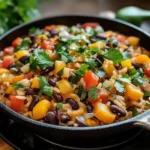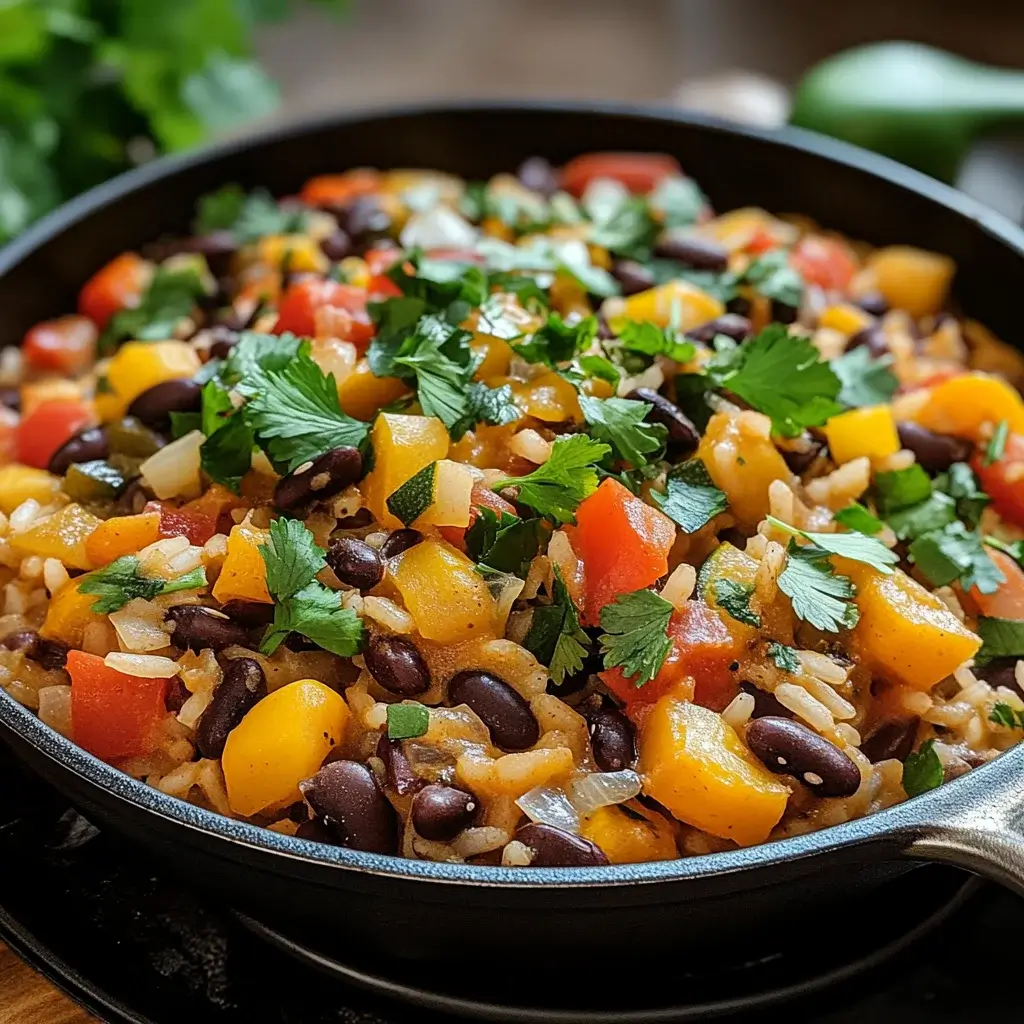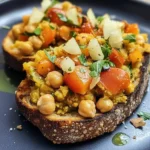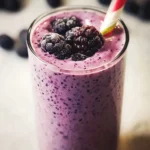Our family dinners can sometimes feel like a culinary tightrope walk – trying to balance everyone’s preferences, my desire for something healthy, and the ever-present constraint of time. But last Tuesday, I think I struck gold. I whipped up this Vegetable & Bean Rice Skillet, and honestly, I was a bit nervous. My youngest can be finicky with mixed dishes, and my husband often craves meat. To my utter delight, the skillet was a resounding success! The aroma alone had everyone peeking into the kitchen. My daughter, who usually picks out vegetables, actually asked for seconds, praising the “colorful confetti rice.” My husband, initially skeptical, admitted it was “surprisingly hearty and flavorful.” It was one of those rare weeknight wins where the plates were cleared, smiles were abundant, and I felt like a kitchen superhero. This dish has officially earned its spot in our regular meal rotation, not just for its ease and health benefits, but for the sheer joy it brought to our dinner table. It’s a vibrant, satisfying, and incredibly versatile meal that I’m thrilled to share.
Ingredients
- 1 tablespoon Olive Oil: Extra virgin, for a robust flavor base and healthy fats.
- 1 medium Onion (chopped): Yellow or white, provides an aromatic foundation.
- 2 cloves Garlic (minced): Fresh garlic for that pungent, essential flavor.
- 1 Red Bell Pepper (chopped): Adds sweetness, vibrant color, and Vitamin C.
- 1 Green Bell Pepper (chopped): Offers a slightly more earthy flavor and more color.
- 1 medium Zucchini (chopped): Brings a tender texture and subtle, fresh taste.
- 1 cup Corn Kernels: Fresh or frozen, for a pop of sweetness and texture.
- 1 can (15 ounces) Black Beans (rinsed and drained): A great source of plant-based protein and fiber.
- 1 can (15 ounces) Kidney Beans (rinsed and drained): Adds another layer of texture, protein, and earthy flavor.
- 1 can (14.5 ounces) Diced Tomatoes (undrained): Provides acidity, moisture, and depth of flavor.
- 1 ½ cups Vegetable Broth: Low sodium preferred, to control the saltiness and cook the rice.
- 1 cup Long-Grain White Rice (uncooked): The starchy staple that brings it all together.
- 1 teaspoon Chili Powder: For a mild, smoky heat.
- 1 teaspoon Cumin: Adds a warm, earthy, and slightly citrusy note.
- ½ teaspoon Smoked Paprika: Lends a deep, smoky flavor and rich color.
- ½ teaspoon Dried Oregano: For a touch of herbaceous, peppery brightness.
- Salt and Black Pepper to taste: Essential for enhancing all the flavors.
- Optional Garnish: Fresh Cilantro (chopped), Lime Wedges, Avocado (sliced or diced), Sour Cream or Greek Yogurt.
Instructions
- Sauté Aromatics: Heat the olive oil in a large, deep skillet or Dutch oven over medium heat. Once the oil is shimmering, add the chopped onion and cook until softened and translucent, about 4-5 minutes, stirring occasionally to prevent burning.
- Add Garlic and Peppers: Stir in the minced garlic and cook for another minute until fragrant. Be careful not to burn the garlic. Add the chopped red and green bell peppers to the skillet. Sauté for 5-7 minutes, until they begin to soften.
- Incorporate More Vegetables: Add the chopped zucchini and corn kernels to the skillet. Cook for another 3-4 minutes, stirring occasionally, until the zucchini is slightly tender-crisp.
- Introduce Beans and Tomatoes: Gently stir in the rinsed and drained black beans and kidney beans. Add the can of undrained diced tomatoes. Mix everything well to combine.
- Spice it Up: Sprinkle in the chili powder, cumin, smoked paprika, and dried oregano. Stir thoroughly to ensure the spices are evenly distributed and coat the vegetables and beans. Cook for a minute more to toast the spices and deepen their flavor.
- Add Rice and Broth: Pour in the uncooked long-grain white rice and the vegetable broth. Stir everything together, making sure the rice is mostly submerged in the liquid.
- Season and Simmer: Season with salt and black pepper to your taste. Remember that the broth might already contain some salt, so taste before adding too much. Bring the mixture to a gentle simmer.
- Cover and Cook: Once simmering, reduce the heat to low, cover the skillet tightly with a lid, and let it cook for 18-20 minutes, or until the rice is tender and most of the liquid has been absorbed. Avoid lifting the lid during this time, as it allows steam to escape and can affect the rice cooking properly.
- Rest the Dish: After the cooking time is up, turn off the heat and let the skillet stand, still covered, for at least 5-10 minutes. This allows the rice to finish steaming and absorb any remaining moisture, resulting in a fluffier texture.
- Fluff and Serve: Remove the lid and gently fluff the rice and vegetable mixture with a fork. Taste and adjust seasoning if necessary.
- Garnish and Enjoy: Serve the Vegetable & Bean Rice Skillet hot, garnished with fresh chopped cilantro, a squeeze of lime juice, sliced avocado, or a dollop of sour cream or Greek yogurt, if desired.
Nutrition Facts
- Servings: 6
- Calories per serving: Approximately 380-420 kcal (This can vary based on exact ingredients and optional toppings.)
- Fiber: High in dietary fiber (approx. 10-12g per serving), promoting digestive health and satiety from the beans, vegetables, and whole grains (if brown rice is used).
- Protein: Good source of plant-based protein (approx. 12-15g per serving), crucial for muscle repair and overall body function, primarily from the beans and rice.
- Vitamins & Minerals: Rich in various vitamins like Vitamin C (from bell peppers, tomatoes), Vitamin A (from carrots if added, bell peppers), and B vitamins, as well as minerals like iron (from beans) and potassium (from tomatoes, beans).
- Complex Carbohydrates: Provides sustained energy release from the rice and beans, making it a fulfilling and energizing meal.
- Low Saturated Fat: When prepared with olive oil and without high-fat animal products, this dish is naturally low in saturated fat, contributing to heart health.
Preparation Time
- Prep Time (Chopping & Measuring): Approximately 20-25 minutes. This involves washing and chopping all the vegetables, mincing the garlic, measuring out spices, and opening cans. Efficiency in chopping can reduce this time.
- Cook Time: Approximately 30-35 minutes. This includes sautéing the aromatics and vegetables, then simmering the rice until tender.
- Resting Time: 5-10 minutes (essential for fluffy rice).
- Total Time: Approximately 55-70 minutes from start to finish, making it a manageable and rewarding weeknight meal.
How to Serve
This Vegetable & Bean Rice Skillet is incredibly versatile and can be served in numerous delightful ways to suit different tastes and occasions. Here are some ideas:
- As a Standalone Main Course:
- Serve generous portions directly from the skillet into bowls. Its hearty combination of rice, beans, and vegetables makes it a complete and satisfying meal on its own.
- This is perfect for a quick weeknight dinner where simplicity is key.
- With Delicious Toppings (Offer a Topping Bar!):
- Freshness & Zest:
- Chopped Fresh Cilantro: Adds a bright, herbaceous note.
- Lime Wedges: A squeeze of fresh lime juice brightens all the flavors.
- Diced Green Onions or Chives: For a mild, fresh oniony bite.
- Creaminess & Richness:
- Sliced or Diced Avocado: Provides healthy fats and a creamy texture.
- Sour Cream or Plain Greek Yogurt: A dollop adds a cool, tangy counterpoint (use dairy-free options for vegans).
- Crumbled Cotija Cheese or Shredded Monterey Jack/Cheddar Cheese: For a salty, cheesy element (use vegan cheese if preferred).
- Crunch & Spice:
- Crushed Tortilla Chips: Adds a delightful crunch and a hint of corn flavor.
- Your Favorite Hot Sauce (e.g., Cholula, Sriracha, Tabasco): For those who like an extra kick of heat.
- Pickled Jalapeños: For a tangy, spicy element.
- Freshness & Zest:
- As a Filling for Wraps or Tacos:
- Spoon the skillet mixture into warm tortillas (corn or flour) for hearty vegetarian tacos or burritos.
- Add lettuce, salsa, and your favorite taco toppings.
- Alongside Complementary Sides:
- Simple Green Salad: A light salad with a vinaigrette dressing can provide a fresh contrast.
- Crusty Bread or Cornbread: Perfect for soaking up any delicious juices.
- A Side of Salsa and Guacamole: Enhances the Southwestern flavors.
- For Meal Prepping:
- Portion the cooked skillet meal into individual containers.
- It reheats beautifully in the microwave or on the stovetop, making it ideal for lunches throughout the week. Keep toppings separate and add after reheating.
- At Potlucks or Gatherings:
- This dish is a crowd-pleaser and travels well.
- It caters to various dietary preferences, especially vegetarians and those looking for healthier options. Bring toppings in separate containers for guests to customize.
No matter how you choose to serve it, this Vegetable & Bean Rice Skillet is sure to be a hit!
Additional Tips
- Veggie Versatility is Your Friend: Don’t feel limited by the vegetables listed! This skillet is a fantastic way to use up whatever you have in your fridge. Consider adding diced carrots (add them with the onions as they take longer to cook), chopped mushrooms (add with the peppers), spinach or kale (stir in at the very end until wilted), or even peas (add with the corn). Seasonal vegetables work wonderfully.
- Rice Variations and Adjustments: While long-grain white rice is standard, you can use brown rice for extra fiber and a nuttier flavor. If using brown rice, note that it will require more liquid (about ¼ to ½ cup extra broth) and a longer cooking time (around 40-45 minutes). Quinoa can also be a great gluten-free, high-protein alternative; adjust liquid and cooking time accordingly (usually less time than rice). Always check package instructions for the specific grain you use.
- Spice Level Customization: Tailor the heat to your preference. For a milder dish, reduce or omit the chili powder. For more heat, add a pinch of cayenne pepper, red pepper flakes, or include a finely chopped jalapeño or serrano pepper (sauté it with the onions and bell peppers). Remember, you can always add hot sauce at the table.
- Bean Swaps and Additions: Black beans and kidney beans are a classic combination, but feel free to use pinto beans, cannellini beans, or even chickpeas (garbanzo beans). Using a mix of beans adds interesting textures and flavors. Ensure they are always rinsed and drained to remove excess sodium and starch.
- Boost the Protein (Vegetarian/Vegan or Meat): For an extra plant-based protein punch, consider adding cubed firm or extra-firm tofu (pan-fry or bake it separately and stir in at the end) or tempeh. If you’re not strictly vegetarian, cooked shredded chicken, ground turkey, or sliced sausage can be added along with the vegetables.
- Don’t Skip the Rest: Allowing the skillet to rest, covered, off the heat for 5-10 minutes after the rice is cooked is crucial. This step allows the steam to finish cooking the rice, making it fluffier and preventing it from being mushy or sticking to the bottom of the pan.
- Cheese, If You Please: If you’re a cheese lover, you can stir in about ½ to 1 cup of shredded cheese (like cheddar, Monterey Jack, or a Mexican blend) after the rice is cooked and the dish has rested. Cover the skillet for a few minutes to allow the cheese to melt beautifully into the dish. For a vegan option, use your favorite dairy-free cheese shreds or a sprinkle of nutritional yeast for a cheesy flavor.
- Make it Ahead for Easy Meal Prep: This dish is fantastic for meal prep. Cook a batch on the weekend, let it cool completely, then portion it into airtight containers. It will keep well in the refrigerator for up to 4 days. Reheat in the microwave or on the stovetop with a splash of water or broth to maintain moisture. This saves a lot of time on busy weekdays.
FAQ Section
Q1: Can I make this Vegetable & Bean Rice Skillet vegan?
A1: Absolutely! This recipe is easily made vegan. The base recipe is already plant-based. Just ensure your vegetable broth is certified vegan (some can contain hidden animal-derived flavorings). For toppings, opt for vegan sour cream, vegan cheese alternatives, or stick to avocado, salsa, and lime, which are naturally vegan.
Q2: Can I use frozen vegetables instead of fresh?
A2: Yes, frozen vegetables are a great time-saving option. You can use frozen chopped onions, bell peppers, corn, and even zucchini. Generally, you don’t need to thaw them before adding to the skillet, but they might release a bit more water. If using a lot of frozen vegetables, you might need to slightly reduce the amount of broth or cook for a few extra minutes to allow any excess moisture to evaporate. Add them at the same stage as you would their fresh counterparts.
Q3: How long will this dish last in the refrigerator?
A3: Properly stored in an airtight container, the Vegetable & Bean Rice Skillet will last for 3-4 days in the refrigerator. Ensure it has cooled completely before refrigerating.
Q4: Can I freeze this recipe?
A4: Yes, this dish freezes quite well, making it excellent for batch cooking. Let it cool completely, then transfer to freezer-safe containers or heavy-duty freezer bags. It can be frozen for up to 2-3 months. To reheat, thaw overnight in the refrigerator and then reheat on the stovetop (you may need to add a splash of water or broth) or in the microwave until heated through. The texture of the rice might be slightly softer after freezing and thawing, but it will still be delicious.
Q5: What if my rice is still crunchy or there’s too much liquid?
A5: If the rice is still crunchy after the recommended cooking time and most of the liquid is absorbed, add another ¼ cup of hot vegetable broth or water, cover, and continue to simmer on low for another 5-10 minutes. If there’s too much liquid but the rice is cooked, remove the lid and cook for a few more minutes on low heat, allowing the excess liquid to evaporate. Be careful not to stir too much, as this can make the rice mushy.
Q6: Can I use a different type of grain instead of white rice?
A6: Yes, you can experiment with other grains. Brown rice is a popular choice for added fiber; it will require more liquid (about ½ cup extra) and a longer cooking time (around 40-45 minutes). Quinoa is a great gluten-free, high-protein option; it typically cooks in about 15-20 minutes and might need slightly less liquid than white rice. Farro or barley could also work, but their cooking times and liquid requirements will vary significantly, so check their package instructions and adjust accordingly.
Q7: Is this Vegetable & Bean Rice Skillet recipe gluten-free?
A7: The core ingredients (rice, beans, vegetables, spices) are naturally gluten-free. However, you must ensure your vegetable broth is certified gluten-free, as some broths can contain gluten-based additives. Also, be mindful of any toppings; for instance, some store-bought tortilla chips or cheese sauces might contain gluten. Always check labels if Celiac disease or severe gluten sensitivity is a concern.
Q8: What’s the best type of skillet to use for this recipe?
A8: A large, deep skillet with a tight-fitting lid is ideal. A 12-inch skillet is usually a good size. Cast iron skillets work wonderfully as they distribute heat evenly and retain it well, which helps in cooking the rice perfectly. A heavy-bottomed stainless steel skillet or a non-stick Dutch oven are also excellent choices. Ensure the skillet is large enough to hold all the ingredients without overcrowding, which can lead to uneven cooking.

Vegetable & Bean Rice Skillet
Ingredients
- 1 tablespoon Olive Oil: Extra virgin, for a robust flavor base and healthy fats.
- 1 medium Onion (chopped): Yellow or white, provides an aromatic foundation.
- 2 cloves Garlic (minced): Fresh garlic for that pungent, essential flavor.
- 1 Red Bell Pepper (chopped): Adds sweetness, vibrant color, and Vitamin C.
- 1 Green Bell Pepper (chopped): Offers a slightly more earthy flavor and more color.
- 1 medium Zucchini (chopped): Brings a tender texture and subtle, fresh taste.
- 1 cup Corn Kernels: Fresh or frozen, for a pop of sweetness and texture.
- 1 can (15 ounces) Black Beans (rinsed and drained): A great source of plant-based protein and fiber.
- 1 can (15 ounces) Kidney Beans (rinsed and drained): Adds another layer of texture, protein, and earthy flavor.
- 1 can (14.5 ounces) Diced Tomatoes (undrained): Provides acidity, moisture, and depth of flavor.
- 1 ½ cups Vegetable Broth: Low sodium preferred, to control the saltiness and cook the rice.
- 1 cup Long-Grain White Rice (uncooked): The starchy staple that brings it all together.
- 1 teaspoon Chili Powder: For a mild, smoky heat.
- 1 teaspoon Cumin: Adds a warm, earthy, and slightly citrusy note.
- ½ teaspoon Smoked Paprika: Lends a deep, smoky flavor and rich color.
- ½ teaspoon Dried Oregano: For a touch of herbaceous, peppery brightness.
- Salt and Black Pepper to taste: Essential for enhancing all the flavors.
- Optional Garnish: Fresh Cilantro (chopped), Lime Wedges, Avocado (sliced or diced), Sour Cream or Greek Yogurt.
Instructions
- Sauté Aromatics: Heat the olive oil in a large, deep skillet or Dutch oven over medium heat. Once the oil is shimmering, add the chopped onion and cook until softened and translucent, about 4-5 minutes, stirring occasionally to prevent burning.
- Add Garlic and Peppers: Stir in the minced garlic and cook for another minute until fragrant. Be careful not to burn the garlic. Add the chopped red and green bell peppers to the skillet. Sauté for 5-7 minutes, until they begin to soften.
- Incorporate More Vegetables: Add the chopped zucchini and corn kernels to the skillet. Cook for another 3-4 minutes, stirring occasionally, until the zucchini is slightly tender-crisp.
- Introduce Beans and Tomatoes: Gently stir in the rinsed and drained black beans and kidney beans. Add the can of undrained diced tomatoes. Mix everything well to combine.
- Spice it Up: Sprinkle in the chili powder, cumin, smoked paprika, and dried oregano. Stir thoroughly to ensure the spices are evenly distributed and coat the vegetables and beans. Cook for a minute more to toast the spices and deepen their flavor.
- Add Rice and Broth: Pour in the uncooked long-grain white rice and the vegetable broth. Stir everything together, making sure the rice is mostly submerged in the liquid.
- Season and Simmer: Season with salt and black pepper to your taste. Remember that the broth might already contain some salt, so taste before adding too much. Bring the mixture to a gentle simmer.
- Cover and Cook: Once simmering, reduce the heat to low, cover the skillet tightly with a lid, and let it cook for 18-20 minutes, or until the rice is tender and most of the liquid has been absorbed. Avoid lifting the lid during this time, as it allows steam to escape and can affect the rice cooking properly.
- Rest the Dish: After the cooking time is up, turn off the heat and let the skillet stand, still covered, for at least 5-10 minutes. This allows the rice to finish steaming and absorb any remaining moisture, resulting in a fluffier texture.
- Fluff and Serve: Remove the lid and gently fluff the rice and vegetable mixture with a fork. Taste and adjust seasoning if necessary.
- Garnish and Enjoy: Serve the Vegetable & Bean Rice Skillet hot, garnished with fresh chopped cilantro, a squeeze of lime juice, sliced avocado, or a dollop of sour cream or Greek yogurt, if desired.
Nutrition
- Serving Size: one normal portion
- Calories: 420
- Fiber: 12g
- Protein: 15g






